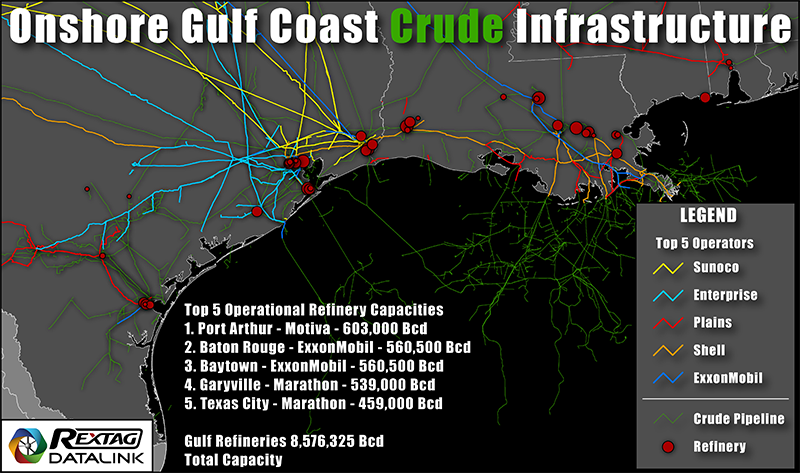Comprehensive Energy Data Intelligence
Information About Energy Companies, Their Assets, Market Deals, Industry Documents and More...
Permian: Oil Pipeline Takeaway. Too Much or Just Fit?
10/17/2017
Midstream key regional players continue to plot new pipelines to take all the petroleum from West Texas to refineries, export hubs and petrochemical plants.
However, even with production from the Permian Basin being up 24% since the year began, the capacities being built may not find their customers.
Almost a two-fold increase in takeaway will mean lower margins. Production will ot keep up with such growth soon enough.
No operator abandons exisitng projects. Yet, a hunt for partners has begun.
Among the players involved are Kinder Morgan Inc. (NYSE: KMI), DCP Midstream LP (NYSE: DPM), and also Targa Resources Corp. (NYSE: TRGP) not to mentione others.
Some analysts say output can accommodate many of the new transportation lines. Permian production should rise through 2026 but it may peak sooner.
The competition for deals to fill the pipelines is so fierce that margins for operating the lines are likely to be thin without consolidation.
If you are looking for more information about energy companies, their assets, and energy deals, please, contact our sales office mapping@hartenergy.com, Tel. 619-349-4970 or SCHEDULE A DEMO to learn how Rextag can help you leverage energy data for your business.
Energy Transfer LP Races to Carry Permian Basin Gas to Gulf Coast Hubs
![$data['article']['post_image_alt']](https://images2.rextag.com/public/blog/Energy-Transfer-LP-Races-to-Carry-Permian-Basin-Gas-to-Gulf-Coast-Hubs.png)
The ever-increasing demand for natural gas exports from the Gulf Coast started a race to further develop Permian Basin. Various companies, including Kinder Morgan and MPLX, are among those looking at building new pipelines in the region due to the demand spike. But Energy Transfer seems to edge past them into the lead since its project strikes as the most economical option for the basin outside of capacity expansions on existing pipelines and could essentially add 1.5-2 Bcf/d of transport capacity with just 260 miles of new pipe.
US Midstream Research 2022 Overview: TOP Providers, Their Assets and Stories
![$data['article']['post_image_alt']](https://images2.rextag.com/public/blog/R 161_ Blog - US Midstream Research Overview TOP Providers, Their Assets and Stories.png)
The midstream sector plays a vital role in the oil and gas supply chain, serving as a crucial link. As the energy transition continues, this industry, like the broader sector, encounters various risks. Yet, existing analyses have predominantly concentrated on the risks faced by the upstream and downstream sectors, leaving the fate of the midstream relatively unexplored. In a nutshell, midstream operators differentiate themselves by offering services instead of products, resulting in potentially distinct revenue models compared to extraction and refining businesses. However, they are not immune to the long-term risks associated with the energy transition away from oil and gas. Over time, companies involved in transporting and storing hydrocarbons face the possibility of encountering a combination of reduced volumes, heightened costs, and declining prices.
![$data['article']['post_image_alt']](https://images2.rextag.com/public/blog/328_Blog_Why Are Oil Giants Backing Away from Green Energy Exxon Mobil, BP, Shell and more .jpg)
As world leaders gather at the COP29 climate summit, a surprising trend is emerging: some of the biggest oil companies are scaling back their renewable energy efforts. Why? The answer is simple—profits. Fossil fuels deliver higher returns than renewables, reshaping priorities across the energy industry.
![$data['article']['post_image_alt']](https://images2.rextag.com/public/blog/327_Blog_Oil Market Outlook A Year of Growth but Slower Than Before.jpg)
The global oil market is full of potential but also fraught with challenges. Demand and production are climbing to impressive levels, yet prices remain surprisingly low. What’s driving these mixed signals, and what role does the U.S. play?
![$data['article']['post_image_alt']](https://images2.rextag.com/public/blog/326_Blog_USA Estimated Annual Rail CO2 Emissions 2035.jpg)
Shell overturned a landmark court order demanding it cut emissions by nearly half. Is this a victory for Big Oil or just a delay in the climate accountability movement?